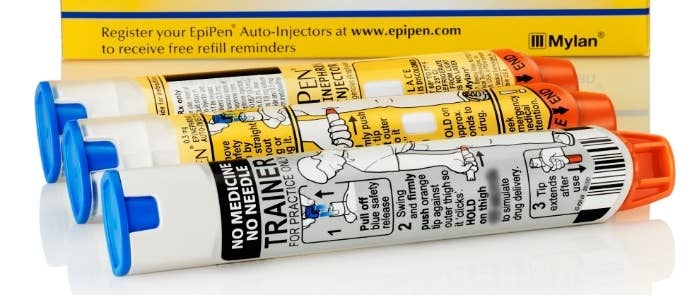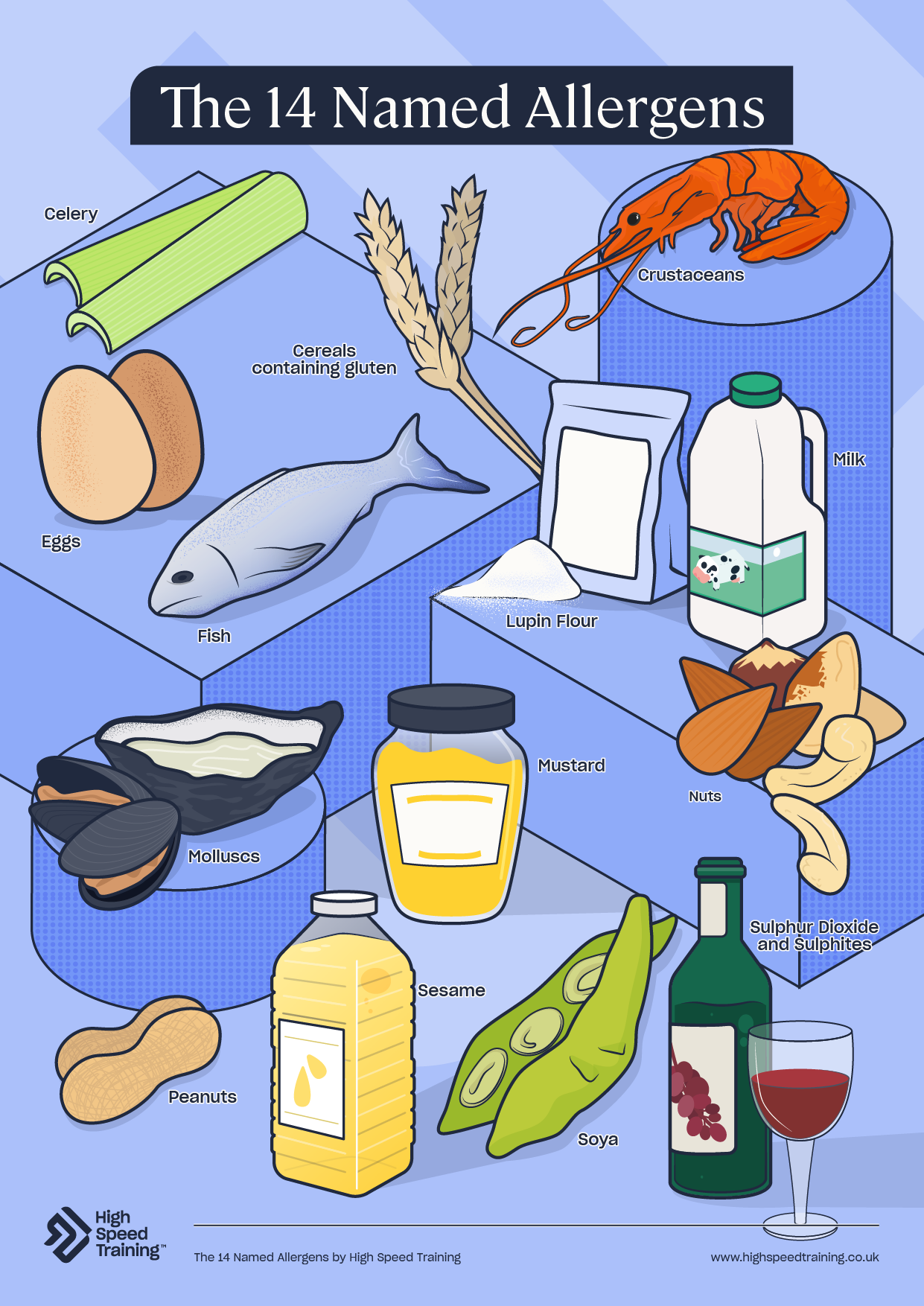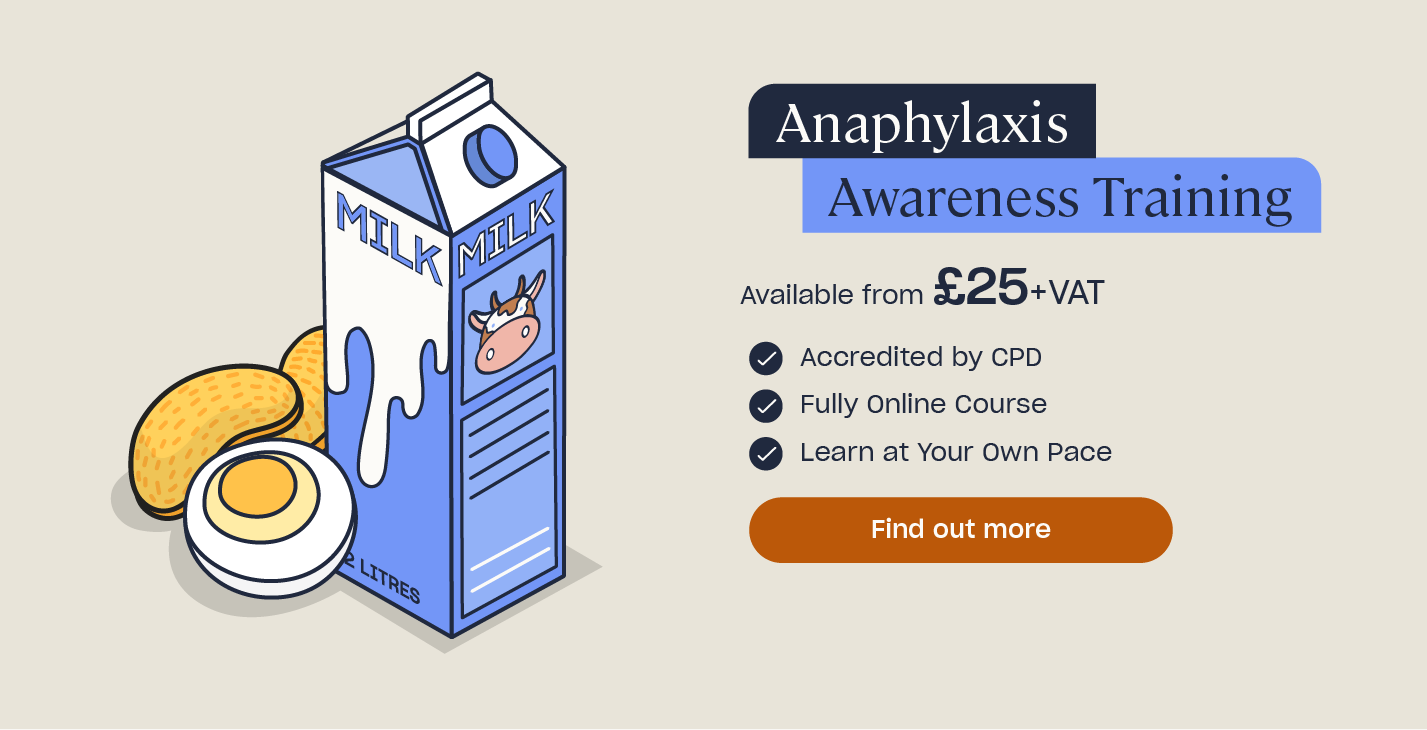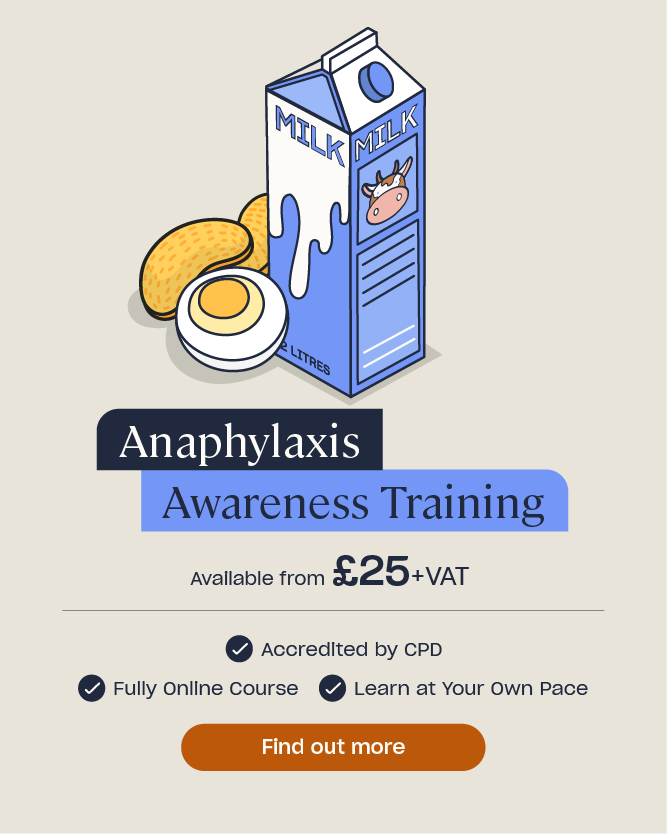What Should a School Food Allergy Policy Cover?
According to Allergy UK, almost one in 12 young children suffer from food allergies. The reactions which children can experience range from mild to life-threatening, with the most severe reaction being anaphylaxis.
With children spending a significant amount of time at school, it is vital that those with food allergies feel safe and can thrive without worrying about an allergic reaction.
In this article, we will outline what a school food allergy policy aims to do and what should be covered in the policy. We will also provide you with an editable example to use so you can feel confident when creating your own policy.

What is a Food Allergy Policy for Schools?
Schools are busy and exciting environments, but for pupils with food hypersensitivities, attending school and managing this can be daunting. It can also be incredibly worrisome for their parents and carers. For some children with food allergies, even trace amounts of a certain ingredient can be enough to trigger a severe reaction, so it’s essential to take these conditions seriously.
It is not only food allergies to be aware of, but also wider food hypersensitivities. The term food hypersensitivity encompasses allergies, intolerances and coeliac disease. Whilst symptoms linked to intolerances and coeliac disease may not be immediately life threatening, they can cause very unpleasant symptoms. Over time, if coeliacs ingest gluten, it can cause serious health issues. If you would like to understand more about food hypersensitivities, take a look at our article: What is Food Hypersensitivity?
Having a food allergy policy can demonstrate the school’s conscientious approach to dealing with food hypersensitivities, and allowing parents and carers to access this can be very reassuring. It shows that consideration has been taken, and additional planning has been carried out to provide a safe environment for children who experience adverse reactions to certain ingredients.
The policy needs to cover information such as the signs of an allergic reaction, how to prepare and serve food safely for pupils with hypersensitivities and how to act in an emergency. It should also be created in line with relevant guidelines and legislation, some of which we will explain below.
Food Allergy School Guidelines
The Children & Families Act 2014 makes it a legal requirement to make arrangements for pupils with medical conditions in school, including food allergies. This means that schools must take time to consider the additional steps needed to provide safe and fulfilling environments for all pupils with food allergies.
When considering the food served at school in particular, The Food Information Regulations, 2014, requires all food businesses, including school caterers, to ensure that allergen information is clearly provided for all food they serve. From October 2021, food which is prepared and packaged on the same site (Pre-Packed for Direct Sale), such as sandwiches and salads, must have a full ingredients list, with allergens clearly highlighted. Your school allergy policy should outline how you operate in line with these regulations.

To make it a little easier to provide for pupils with food hypersensitivities, many will have an Individual Healthcare Plan (IHP), which is created by a medical professional, such as their GP. Considering the guidance offered in children’s IHP’s can be incredibly helpful when designing a Food Allergy Policy.
Recently, a campaign by the Benedict Blythe Foundation was launched, calling for several steps to become mandatory in schools regarding allergies and anaphylaxis. One of these was for all schools to have an effective allergy policy, including an anaphylaxis plan. It also calls for the provision for children with food allergies to be monitored more closely by Ofsted.
Taking all of this into account, it’s clear that managing food hypersensitivities safely in school is a vital element of safeguarding children. You can learn more about the legislation surrounding all parts of safeguarding in our hub article here.
What Should a School Food Allergy Policy Include?
The details of what should be included in your food allergy policy will depend on the specific risks in your setting. However, all policies need to cover certain essential topics. With this in mind, your food allergy policy must cover the following:
- An explanation of allergies and anaphylaxis – this should include the symptoms to look out for, which might indicate an allergic reaction, alongside a clear explanation of anaphylaxis and the 14 food allergens which pupils are most likely to react to.
- Details of specific roles and responsibilities – in this section, you should explain the roles of teachers and parents, alongside any additional specific roles such as that of the headteacher or school nurse.
- An anaphylaxis emergency response plan – the response plan should detail exactly what to do should a pupil experience an anaphylactic reaction, including where to locate Adrenaline Auto-Injectors (AAIs) and how and when to use these. This section should also detail how AAIs are stored correctly.
- An outline of the training provided for staff – the policy must also detail how staff are trained to deal with allergic reactions, including anaphylaxis. It is imperative that staff are trained properly to respond to an emergency confidently and effectively.
- Details of catering arrangements – how catering is planned and provided for pupils with food allergies and hypersensitivities should be outlined, including how this is communicated to parents/carers. It should also include how allergens are managed concerning pupils bringing food from home into school.
- How effective communication is achieved – you should consider how food allergy awareness is shared amongst staff, pupils and parents. This will allow you to achieve awareness and understanding amongst the whole school community.
- Risk assessment – the policy should also cover how risk assessments are carried out for food allergies in school, educational visits and other extracurricular activities.
- Safeguarding – pupils with food allergies are likely to require an additional level of safeguarding, and this should also be outlined in the policy. A rising issue in schools is allergy bullying. Schools should be aware of this and plan how this is dealt with in the safeguarding section of their policy. You can read more about this in our hub article: How to Spot Allergy Bullying.
Looking to Learn More?
We offer various courses designed to provide the skills needed to cater for and safeguard those with food allergies and hypersensitivities, such as our Food Allergen Awareness Course, or Anaphylaxis Awareness.
Should I Have A Nut Free School Policy?
With nut allergies being one of the most common food allergies among children, it may seem like having a completely nut-free policy is the best way forward. However, this should be approached cautiously, and some allergy experts advise against this.
This is because it can be very challenging for staff to monitor this type of policy. Many children bring a packed lunch to school, and food items containing nuts can easily be brought into school this way. Even with vigilance from parents, it might not always be obvious that a product contains nuts and with busy households, it’s easy for a mistake to happen. To understand more about precautionary allergy food labelling, take a look at our article here.

It’s also worth noting that labelling the school as ‘nut free’ may create a false sense of security and can cause pupils, staff and parents to be a little more complacent when it comes to the management and monitoring of food allergies.
However, the decision regarding whether or not to implement a nut free policy depends upon the school itself. For example, a nut free policy is seen more often in Primary Schools than Secondary Schools. This is because a smaller site, and reduced number of pupils in a Primary School may mean that a nut free policy can be monitored more carefully and is therefore considered to be achievable.
Can Schools Have Spare Adrenaline Auto Injectors?
Adrenaline Auto Injectors (AAIs) are used to treat severe anaphylactic reactions; you may recognise them from their brand names ‘Epipen’ or ‘Jext’. Part of the campaign mentioned earlier by the Benedict Blythe Foundation calls for schools to ensure they have spare, in-date AAIs available at all times.

By law, schools can obtain spare AAIs without a prescription. However, they are not required to do so. There are benefits to holding spare AAIs, though. For example, one can be administered if a pupil suffers an anaphylactic shock and has forgotten their AAI, it is out of date, broken or initially administered incorrectly. It is crucial, however, that any staff member who administers an AAI has received training to allow them to do this correctly.
You should state your school’s position on this matter in your policy. If the school does choose to have spare AAIs, the policy needs to explain how and where they are stored and detail the situations in which they may be used.
Example School Food Allergy Policy
As we’ve explained throughout this article, having a comprehensive allergen policy in place is essential to protect the staff and pupils who suffer from food hypersensitivities. To help with this, we have created an editable school food allergy policy example that you can use within your school.
Our template has space for you to edit and fill in your school’s details and contains the following sections:
- Introduction.
- Background information.
- Roles and responsibilities.
- Emergency anaphylaxis response plan.
- Supply, storage and care of medication.
- The storage and use of spare adrenaline auto injectors in school.
- Staff training.
- Safeguarding.
- Catering.
- Extra-curricular activities.
- Communication and allergy awareness.
- Risk assessment.
Whilst this example policy exemplifies what should be included in each section, you must tailor your allergen policy to the specific nature of your school and the risks associated with your setting.
You can download our editable example policy at the button below:
Free Food Allergens Poster for Schools
Print out and display this handy poster in school kitchens, snack areas and around the classroom to make sure everyone is kept informed.
We hope you have found this article helpful and informative. Keeping pupils with food hypersensitivities safe at school is paramount and takes careful planning and consideration. An effective food allergy policy can help you ensure that the school community is confident, prepared and aware of how best to safeguard pupils with allergies and allow them to relax and enjoy their time at school.
Further Resources:
- Anaphylaxis Awareness Training
- Spotting the Signs of an Allergic Reaction to Food
- Free 14 Allergens Poster
- What are the Food Hygiene Requirements in a School?
- Food Allergen Awareness Training












